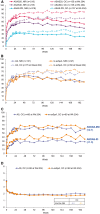Sustained efficacy, safety and patient-reported outcomes of certolizumab pegol in axial spondyloarthritis: 4-year outcomes from RAPID-axSpA
- PMID: 28498975
- PMCID: PMC5850296
- DOI: 10.1093/rheumatology/kex174
Sustained efficacy, safety and patient-reported outcomes of certolizumab pegol in axial spondyloarthritis: 4-year outcomes from RAPID-axSpA
Abstract
Objective: The aim was to assess the long-term safety and efficacy of certolizumab pegol over 4 years of continuous treatment in patients with axial spondyloarthritis (axSpA), including both AS and non-radiographic (nr-) axSpA.
Methods: RAPID-axSpA was a phase 3 randomized trial, double blind and placebo controlled to week 24, dose blind to week 48 and open label to week 204. Patients had a clinical diagnosis of axSpA, meeting Assessment of SpondyloArthritis international Society (ASAS) criteria, and had active disease. The assessed outcomes included ASAS20, ASAS40, AS DAS (ASDAS), BASDAI, BASFI and BASMI scores, along with selected measures of remission. Further patient-reported outcomes, peripheral arthritis, enthesitis, uveitis and quality-of-life measures are also reported.
Results: Two hundred and eighteen of 325 patients randomized (AS: 121; nr-axSpA: 97) received certolizumab pegol from week 0. Of these, 65% remained in the study at week 204 (AS: 67%; nr-axSpA: 63%). Across all outcomes, for AS and nr-axSpA, sustained improvements were observed to week 204 [week 204 overall axSpA: ASAS20: 54.1% (non-responder imputation); 83.7% (observed case, OC); ASAS40: 44.0% (non-responder imputation); 68.1% (OC); ASDAS inactive disease: 32.1% (last observation carried forward); 31.4% (OC)]. In the safety set (n = 315), there were 292.8 adverse events and 10.4 serious adverse events per 100 patient-years. No deaths were reported.
Conclusion: In the first study to evaluate the efficacy of an anti-TNF across both axSpA subpopulations, improvements in clinical and patient-reported outcomes at 24 and 96 weeks were sustained through 4 years of treatment, with no new safety signals.
Trial registration: ClinicalTrials.gov, http://clinicaltrials.gov, NCT01087762.
Keywords: ankylosing spondylitis; axial spondyloarthritis; certolizumab pegol; non-radiographic axial spondyloarthritis.
© The Author 2017. Published by Oxford University Press on behalf of the British Society for Rheumatology.
Figures



Similar articles
-
Effect of certolizumab pegol over ninety-six weeks in patients with axial spondyloarthritis: results from a phase III randomized trial.Arthritis Rheumatol. 2015 Mar;67(3):668-77. doi: 10.1002/art.38973. Arthritis Rheumatol. 2015. PMID: 25470228 Free PMC article. Clinical Trial.
-
Efficacy of certolizumab pegol on signs and symptoms of axial spondyloarthritis including ankylosing spondylitis: 24-week results of a double-blind randomised placebo-controlled Phase 3 study.Ann Rheum Dis. 2014 Jan;73(1):39-47. doi: 10.1136/annrheumdis-2013-204231. Epub 2013 Sep 6. Ann Rheum Dis. 2014. PMID: 24013647 Free PMC article. Clinical Trial.
-
Discriminant validity, responsiveness and reliability of the arthritis-specific Work Productivity Survey assessing workplace and household productivity within and outside the home in patients with axial spondyloarthritis, including nonradiographic axial spondyloarthritis and ankylosing spondylitis.Arthritis Res Ther. 2014 Aug 6;16(4):R164. doi: 10.1186/ar4680. Arthritis Res Ther. 2014. PMID: 25099160 Free PMC article. Clinical Trial.
-
Certolizumab pegol for treating axial spondyloarthritis.Expert Opin Biol Ther. 2016 Aug;16(8):1059-64. doi: 10.1080/14712598.2016.1205581. Expert Opin Biol Ther. 2016. PMID: 27366922 Review.
-
Efficacy of TNFα blockers in patients with ankylosing spondylitis and non-radiographic axial spondyloarthritis: a meta-analysis.Ann Rheum Dis. 2015 Jun;74(6):1241-8. doi: 10.1136/annrheumdis-2014-205322. Epub 2014 Apr 9. Ann Rheum Dis. 2015. PMID: 24718959 Review.
Cited by
-
Site-specific resolution of enthesitis in patients with axial spondyloarthritis treated with tumor necrosis factor inhibitors.Arthritis Res Ther. 2021 Jun 9;23(1):165. doi: 10.1186/s13075-021-02534-7. Arthritis Res Ther. 2021. PMID: 34107999 Free PMC article.
-
Certolizumab Pegol Treatment in Patients with Axial-Spondyloarthritis-Associated Acute Anterior Uveitis: a Narrative Review.Rheumatol Ther. 2022 Dec;9(6):1481-1497. doi: 10.1007/s40744-022-00486-1. Epub 2022 Sep 30. Rheumatol Ther. 2022. PMID: 36178585 Free PMC article. Review.
-
Evaluation of concomitant peripheral arthritis in patients with recent onset axial spondyloarthritis: 5-year results from the DESIR cohort.Arthritis Res Ther. 2019 Jun 6;21(1):139. doi: 10.1186/s13075-019-1927-6. Arthritis Res Ther. 2019. PMID: 31171034 Free PMC article.
-
Long-term clinical outcomes of certolizumab pegol treatment in non-radiographic axial spondyloarthritis stratified by baseline MRI and CRP status.RMD Open. 2024 May 9;10(2):e003884. doi: 10.1136/rmdopen-2023-003884. RMD Open. 2024. PMID: 38724259 Free PMC article. Clinical Trial.
-
Effectiveness of secukinumab in radiographic and non-radiographic axial spondyloarthritis: a European routine-care observational study.RMD Open. 2024 Jul 24;10(3):e004166. doi: 10.1136/rmdopen-2024-004166. RMD Open. 2024. PMID: 39053949 Free PMC article.
References
-
- Linden SVD, Valkenburg HA, Cats A.. Evaluation of diagnostic criteria for ankylosing spondylitis. Arthritis Rheum 1984;27:361–8. - PubMed
-
- Rudwaleit M, van der Heijde D, Landewe R. et al. The development of Assessment of SpondyloArthritis international Society classification criteria for axial spondyloarthritis (part II): validation and final selection. Ann Rheum Dis 2009;68:777–83. - PubMed
-
- Stolwijk C, van Tubergen A, Castillo-Ortiz JD, Boonen A.. Prevalence of extra-articular manifestations in patients with ankylosing spondylitis: a systematic review and meta-analysis. Ann Rheum Dis 2015;74:65–73. - PubMed
Publication types
MeSH terms
Substances
Associated data
LinkOut - more resources
Full Text Sources
Other Literature Sources
Medical
Research Materials

